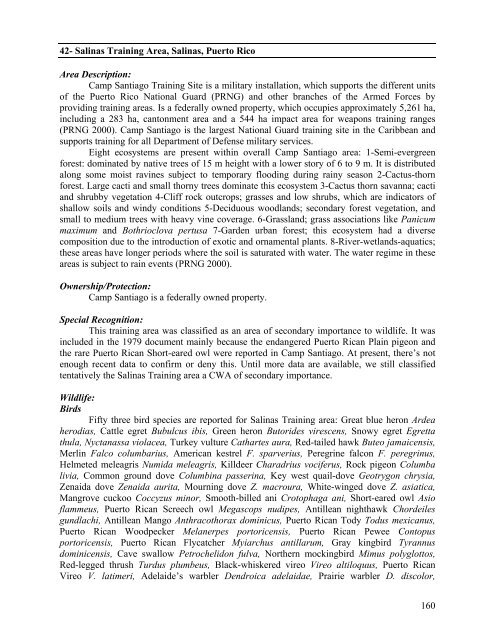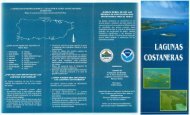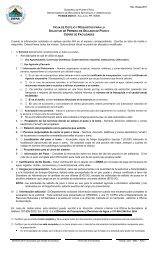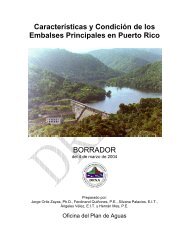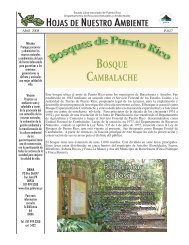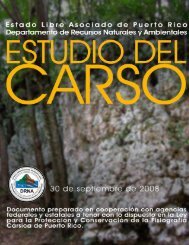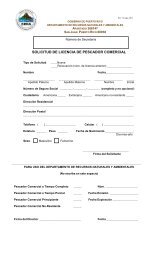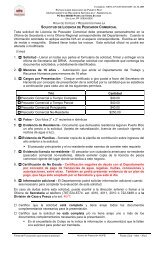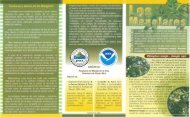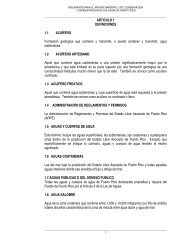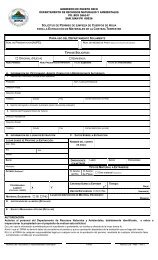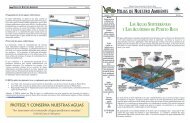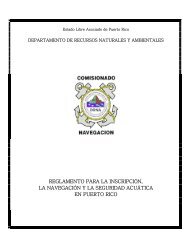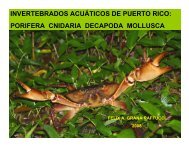Puerto Rico Critical Wildlife Areas - Puerto DRNA - Gobierno de ...
Puerto Rico Critical Wildlife Areas - Puerto DRNA - Gobierno de ...
Puerto Rico Critical Wildlife Areas - Puerto DRNA - Gobierno de ...
You also want an ePaper? Increase the reach of your titles
YUMPU automatically turns print PDFs into web optimized ePapers that Google loves.
42- Salinas Training Area, Salinas, <strong>Puerto</strong> <strong>Rico</strong><br />
Area Description:<br />
Camp Santiago Training Site is a military installation, which supports the different units<br />
of the <strong>Puerto</strong> <strong>Rico</strong> National Guard (PRNG) and other branches of the Armed Forces by<br />
providing training areas. Is a fe<strong>de</strong>rally owned property, which occupies approximately 5,261 ha,<br />
including a 283 ha, cantonment area and a 544 ha impact area for weapons training ranges<br />
(PRNG 2000). Camp Santiago is the largest National Guard training site in the Caribbean and<br />
supports training for all Department of Defense military services.<br />
Eight ecosystems are present within overall Camp Santiago area: 1-Semi-evergreen<br />
forest: dominated by native trees of 15 m height with a lower story of 6 to 9 m. It is distributed<br />
along some moist ravines subject to temporary flooding during rainy season 2-Cactus-thorn<br />
forest. Large cacti and small thorny trees dominate this ecosystem 3-Cactus thorn savanna; cacti<br />
and shrubby vegetation 4-Cliff rock outcrops; grasses and low shrubs, which are indicators of<br />
shallow soils and windy conditions 5-Deciduous woodlands; secondary forest vegetation, and<br />
small to medium trees with heavy vine coverage. 6-Grassland; grass associations like Panicum<br />
maximum and Bothrioclova pertusa 7-Gar<strong>de</strong>n urban forest; this ecosystem had a diverse<br />
composition due to the introduction of exotic and ornamental plants. 8-River-wetlands-aquatics;<br />
these areas have longer periods where the soil is saturated with water. The water regime in these<br />
areas is subject to rain events (PRNG 2000).<br />
Ownership/Protection:<br />
Camp Santiago is a fe<strong>de</strong>rally owned property.<br />
Special Recognition:<br />
This training area was classified as an area of secondary importance to wildlife. It was<br />
inclu<strong>de</strong>d in the 1979 document mainly because the endangered <strong>Puerto</strong> Rican Plain pigeon and<br />
the rare <strong>Puerto</strong> Rican Short-eared owl were reported in Camp Santiago. At present, there’s not<br />
enough recent data to confirm or <strong>de</strong>ny this. Until more data are available, we still classified<br />
tentatively the Salinas Training area a CWA of secondary importance.<br />
<strong>Wildlife</strong>:<br />
Birds<br />
Fifty three bird species are reported for Salinas Training area: Great blue heron Ar<strong>de</strong>a<br />
herodias, Cattle egret Bubulcus ibis, Green heron Butori<strong>de</strong>s virescens, Snowy egret Egretta<br />
thula, Nyctanassa violacea, Turkey vulture Cathartes aura, Red-tailed hawk Buteo jamaicensis,<br />
Merlin Falco columbarius, American kestrel F. sparverius, Peregrine falcon F. peregrinus,<br />
Helmeted meleagris Numida meleagris, Kill<strong>de</strong>er Charadrius vociferus, Rock pigeon Columba<br />
livia, Common ground dove Columbina passerina, Key west quail-dove Geotrygon chrysia,<br />
Zenaida dove Zenaida aurita, Mourning dove Z. macroura, White-winged dove Z. asiatica,<br />
Mangrove cuckoo Coccyzus minor, Smooth-billed ani Crotophaga ani, Short-eared owl Asio<br />
flammeus, <strong>Puerto</strong> Rican Screech owl Megascops nudipes, Antillean nighthawk Chor<strong>de</strong>iles<br />
gundlachi, Antillean Mango Anthracothorax dominicus, <strong>Puerto</strong> Rican Tody Todus mexicanus,<br />
<strong>Puerto</strong> Rican Woodpecker Melanerpes portoricensis, <strong>Puerto</strong> Rican Pewee Contopus<br />
portoricensis, <strong>Puerto</strong> Rican Flycatcher Myiarchus antillarum, Gray kingbird Tyrannus<br />
dominicensis, Cave swallow Petrochelidon fulva, Northern mockingbird Mimus polyglottos,<br />
Red-legged thrush Turdus plumbeus, Black-whiskered vireo Vireo altiloquus, <strong>Puerto</strong> Rican<br />
Vireo V. latimeri, A<strong>de</strong>lai<strong>de</strong>’s warbler Dendroica a<strong>de</strong>laidae, Prairie warbler D. discolor,<br />
160


